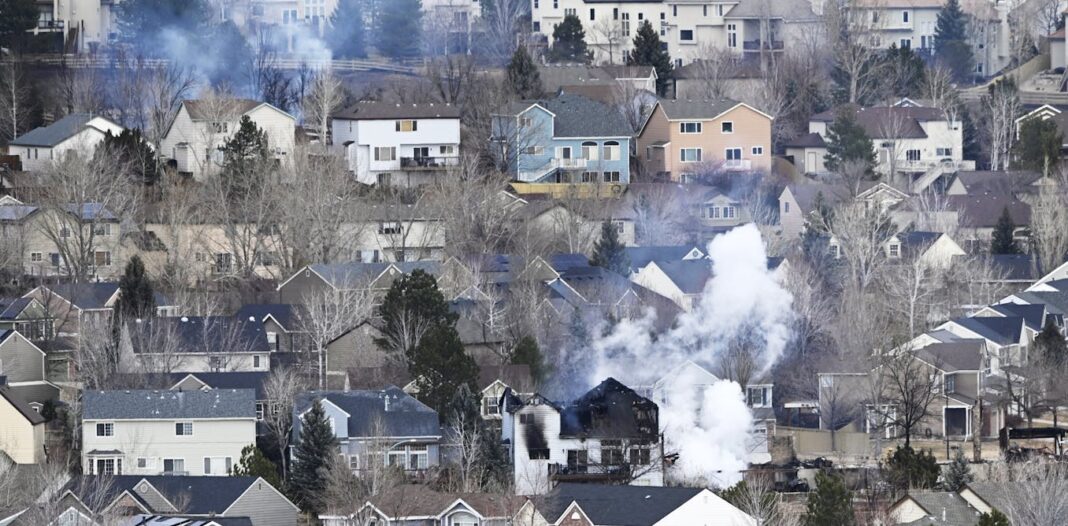After the Wildfire: The Hidden Dangers of Smoke-Damaged Homes
On Dec. 30, 2021, a wind-driven wildfire raced through two communities just outside Boulder, Colorado. In the span of about eight hours, more than 1,000 homes and businesses burned.
The fire left entire blocks in ash, but among them, pockets of houses survived seemingly untouched. The owners of these homes may have felt relief at first. But fire damage can be deceiving, as many soon discovered.
When wildfires like the Marshall Fire reach the wildland-urban interface, they are burning both vegetation and human-made materials. Vehicles and buildings burn, along with all of the things inside them – electronics, paint, plastics, furniture.
Research shows that when human-made materials like these burn, the chemicals released are different from what is emitted when just vegetation burns. The smoke and ash can blow under doors and around windows in nearby homes, bringing in chemicals that stick to walls and other indoor surfaces and continue off-gassing for weeks to months, particularly in warmer temperatures.
In a new study released three years after the Marshall Fire, my colleagues and I looked at the health effects people experienced when they returned to still-standing homes. We also created a checklist for people to use after urban wildfires in the future to help them protect their health and reduce their risks when they return to smoke-damaged homes.
Tests in homes found elevated metals and VOCs
In the days after the Marshall Fire, residents quickly reached out to nearby scientists who study wildfire smoke and health risks at the University of Colorado Boulder and area labs. People wanted to know what was in the ash and causing the lingering smells inside their homes.
In homes we were able to test, my colleagues found elevated levels of metals and PAHs – polycyclic aromatic hydrocarbons – in the ash. We also found elevated VOCs – volatile organic compounds – in airborne samples. Some VOCs, such as dioxins, benzene, formaldehyde, and PAHs, can be toxic to humans. Benzene is a known carcinogen.
Symptoms 6 months after the fire
Even six months after the fire, we found that many people were reporting symptoms that aligned with health risks related to smoke and ash from fires.
More than half (55%) of the people who responded to our survey reported that they were experiencing at least one symptom six months after the blaze that they attributed to the Marshall Fire. The most common symptoms reported were itchy or watery eyes (33%), headache (30%), dry cough (27%), sneezing (26%), and sore throat (23%).
Lingering symptoms and questions
There are a still a lot of unanswered questions about the health risks from smoke- and ash-damaged homes.
For example, we don’t yet know what long-term health implications might look like for people living with lingering gases from wildfire smoke and ash in a home.
We found a significant decline in the number of people reporting symptoms one year after the fire. However, 33% of the people whose homes were affected still reported at least one symptom that they attributed to the fire. About the same percentage also reported at least one symptom two years after the fire.
Tips to protect yourself after future wildfires
Wildfires are increasingly burning homes and other structures as more people move into the wildland-urban interface, temperatures rise, and fire seasons lengthen.
It can be confusing to know what to do if your home is one that survives a wildfire nearby. To help, my colleagues and I put together a website of steps to take if your home is ever infiltrated by smoke or ash from a wildfire.
Here are a few of those steps:
- When you’re ready to clean your home, start by protecting yourself. Wear at least an N95 (or KN95) mask and gloves, goggles and clothing that covers your skin.
- Vacuum floors, drapes, and furniture. But avoid harsh chemical cleaners because they can react with the chemicals in the ash.
- Clean your HVAC filter and ducts to avoid spreading ash further. Portable air cleaners with carbon filters can help remove VOCs.
Conclusion
Given that we don’t know much yet about the health harms of smoke- and ash-damaged homes, it is important to take care in how you clean so you can do the most to protect your health.
Frequently Asked Questions
Q: What are the most common symptoms associated with smoke- and ash-damaged homes?
A: The most common symptoms reported were itchy or watery eyes, headache, dry cough, sneezing, and sore throat.
Q: How long do the symptoms of smoke- and ash-damaged homes last?
A: We found that 33% of the people whose homes were affected still reported at least one symptom two years after the fire.
Q: What can I do to protect myself from the health risks of smoke- and ash-damaged homes?
A: Wear protective gear, vacuum and clean carefully, and use air purifiers to remove VOCs.




